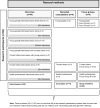Being as Normal as Possible: How Young People Ages 16-25 Years Evaluate the Risks and Benefits of Treatment for Inflammatory Arthritis
- PMID: 27040737
- PMCID: PMC5042182
- DOI: 10.1002/acr.22832
Being as Normal as Possible: How Young People Ages 16-25 Years Evaluate the Risks and Benefits of Treatment for Inflammatory Arthritis
Abstract
Objective: To explore how young people (ages 16-25 years) with inflammatory arthritis evaluate the risks and benefits of treatment, particularly treatment with biologic therapies.
Methods: This qualitative study involved in-depth interviews (n = 44) with young people, trusted others (e.g., parents), and health professionals; audio-recordings (n = 4) of biologic therapy-related consultations; and focus groups (n = 4). Analysis used techniques from grounded theory (open and focused coding, constant comparison, memoing, and mapping).
Results: Young people aspired to live what they perceived as a "normal" life. They saw treatment as presenting both an opportunity for and a threat to achieving this. Treatment changes were therefore subject to complex and ongoing evaluation, covering administration, associated restrictions, anticipated effects, and side effects. Information sources included expert opinion (of professionals and other patients) and personal experience. Previous treatments provided important reference points. Faced with uncertain outcomes, young people made provisional decisions. Both trusted others and health professionals expressed concern that young people were too focused on short-term outcomes.
Conclusion: Young people value treatment that helps them to live a "normal" life. There is more to this than controlling disease. The emotional, social, and vocational consequences of treatment can be profound and lasting: opportunities to discuss the effects of treatment should be provided early and regularly. While making every effort to ensure understanding of the long-term clinical consequences of taking or not taking medication, the wider impact of treatment should not be dismissed. Only through understanding young people's values, preferences, and concerns can a sustainable balance between disease control and treatment burden be achieved.
© 2016 The Authors. Arthritis Care & Research published by Wiley Periodicals, Inc. on behalf of the American College of Rheumatology.
Figures
Similar articles
-
Young people's decisions about biologic therapies: who influences them and how?Rheumatology (Oxford). 2015 Jul;54(7):1294-301. doi: 10.1093/rheumatology/keu523. Epub 2015 Feb 5. Rheumatology (Oxford). 2015. PMID: 25661469 Free PMC article.
-
Folic acid supplementation and malaria susceptibility and severity among people taking antifolate antimalarial drugs in endemic areas.Cochrane Database Syst Rev. 2022 Feb 1;2(2022):CD014217. doi: 10.1002/14651858.CD014217. Cochrane Database Syst Rev. 2022. PMID: 36321557 Free PMC article.
-
Qualitative Study.2022 Sep 18. In: StatPearls [Internet]. Treasure Island (FL): StatPearls Publishing; 2025 Jan–. 2022 Sep 18. In: StatPearls [Internet]. Treasure Island (FL): StatPearls Publishing; 2025 Jan–. PMID: 29262162 Free Books & Documents.
-
Types and aspects of support that young carers need and value, and barriers and enablers to access: the REBIAS-YC qualitative study.Health Soc Care Deliv Res. 2024 Sep;12(36):1-108. doi: 10.3310/ABAT6761. Health Soc Care Deliv Res. 2024. PMID: 39324762
-
Behavioural modification interventions for medically unexplained symptoms in primary care: systematic reviews and economic evaluation.Health Technol Assess. 2020 Sep;24(46):1-490. doi: 10.3310/hta24460. Health Technol Assess. 2020. PMID: 32975190 Free PMC article.
Cited by
-
Patient-reported outcome assessment of inflammatory arthritis patient experience with intravenously administered biologic therapy.Patient Prefer Adherence. 2017 Sep 12;11:1543-1553. doi: 10.2147/PPA.S136567. eCollection 2017. Patient Prefer Adherence. 2017. PMID: 28979103 Free PMC article.
-
Patient preferences for rheumatoid arthritis treatment.Curr Opin Rheumatol. 2019 May;31(3):256-263. doi: 10.1097/BOR.0000000000000591. Curr Opin Rheumatol. 2019. PMID: 30747733 Free PMC article. Review.
-
Impact of systemic juvenile idiopathic arthritis/Still's disease on adolescents as evidenced through social media posts.Open Access Rheumatol. 2018 Jun 13;10:73-81. doi: 10.2147/OARRR.S165010. eCollection 2018. Open Access Rheumatol. 2018. PMID: 29942167 Free PMC article.
-
"Sometimes I feel like a pharmacist": identity and medication use among adolescents with juvenile arthritis.Pediatr Rheumatol Online J. 2016 Oct 19;14(1):57. doi: 10.1186/s12969-016-0117-1. Pediatr Rheumatol Online J. 2016. PMID: 27756328 Free PMC article.
-
What do young people with rheumatic conditions in the UK think about research involvement? A qualitative study.Pediatr Rheumatol Online J. 2018 May 24;16(1):35. doi: 10.1186/s12969-018-0251-z. Pediatr Rheumatol Online J. 2018. PMID: 29793489 Free PMC article.
References
-
- Mulley A, Trimble C, Elwyn G. Patients’ preferences matter: stop the silent misdiagnosis. London: The King's Fund; 2012. - PubMed
-
- Marshall N, Wilson G, Lapworth K, Kay L. Patients’ perceptions of treatment with anti‐TNF therapy for rheumatoid arthritis: a qualitative study. Rheumatology (Oxford) 2004;43:1034–8. - PubMed
Publication types
MeSH terms
Substances
Grants and funding
LinkOut - more resources
Full Text Sources
Other Literature Sources
Medical


